Andreas Sandre
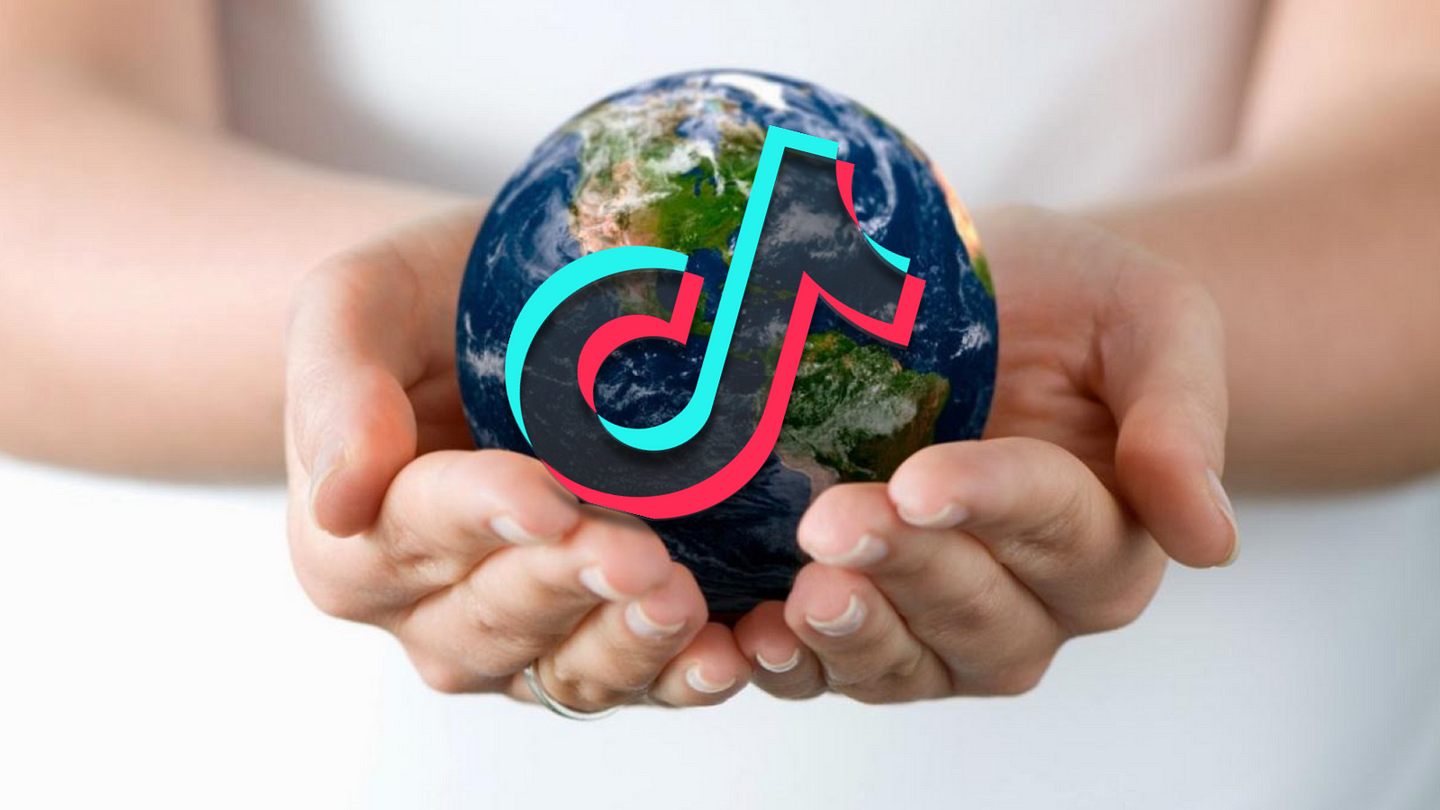
Ispent the summer interviewing the social media managers behind some of the hottest TikTok accounts in the social impact and digital diplomacy space. I also spoke to experts and scholars to better understand how TikTok is growing in this space. And I asked TikTok creators and influencers about their experience on the platform and their advice for both users and organizations to amplify the causes they believe in.
What a summer it has been!
I learned so much about TikTok. Most of all, I had lots of fun experimenting with content and exploring the many innovative ways international organizations, global and local NGOs, advocacy groups, charities, and government entities use TikTok to engage with new audiences and drive awareness around a key issue or programs, from gender equality and refugees, to climate change and migrations.
This handbook is the result of my research, interviews, and my own experimenting on the platform. It does not represent the views of TikTok or of the organizations cited in the manual.
The trailblazers
What social impact organizations are already on TikTok?
The number of organizations on TikTok is growing constantly. They include the United Nations (40.9K Followers; 275K Likes) and many of its agencies and programs (data as of September 12, 2020):
World Health Organization (2.6M Followers; 8.9M Likes)
IOM - UN Migration (1.5M Followers; 2M Likes)
UN Refugee Agency (1.1M Followers; 2M Likes)
UNICEF (59.2K Followers; 3.6M Likes)
UN Food and Agriculture Organization —FAO Newsroom (173.6K Followers; 1.9M Likes)
Also IFAD, UN Environment Programme, UN Women, as well as other international organizations like the WTO and OECD.
Many global and regional non-governmental organizations and non-profits are active on the platform as well. They include (data as of September 12, 2020):
International Federation of the Red Cross and Crescent Societies — IFRC (3.4M Followers; 10.6M Likes)
World Economic Forum (1.5M Followers; 14.9M Likes)
American Red Cross (471.9K Followers; 6.2M Likes)
British Red Cross (381.5K Followers; 6.2M Likes)
United Way (72.3K Followers; 539.7K Likes)
Conservation Intl (60.8K Followers; 861.9K Likes)
(RED) (36.8K Followers; 276.1K Likes)
Oceana (26.4K Followers; 152.6K Likes)
Giving Tuesday (14.3K Followers; 518.8K Likes)
Also Amnesty International, Malala Fund, charity: water, DoSomething.org, Earth Hour, Gavi, Girls Who Code, Greenpeace, IFAW, Islamic Relief Worldwide, Médecins Sans Frontières — Doctors Without Borders, Oxfam International, Plan International, Save the Children, United Nations Foundation, WaterAid UK, World Vision, Bloomberg Philanthropies, and WWF.
Why TikTok for social impact and digital diplomacy?
Inthe past 12 months, TikTok has consistently been at the top of the download charts on the Apple AppStore and for Android and Google Play. According to Sensor Tower, it was the top app worldwide by overall downloads for last 4 consecutive months (May to August) and led app downloads on the AppStore 9 out of the past 12 months — overall, it topped the charts 7 out of 12 months.
When I posted the tweet above, Luca Lamorte at the IOM — UN Migration responded:
Luca Lamorte on Twitter.
In Europe alone, TikTok just marked the 100 million user milestone, according to Rich Waterworth, TikTok Europe General Manager.
“We’ve been humbled to see how Europe has embraced TikTok during the time we’ve been here,” writes Rich in a company statement. “Today, more than 100 million people across the region are active on TikTok every month. TikTok is a home for positive, creative expression — and from beauty, comedy and education, to magic, music and sport, we offer a brand of joyful entertainment that’s authentic, relatable, and truly diverse.”
TikTok exponential growth and its video content viral potential represent a great base for non-profits and other organizations to explore the platform even further. It “can potentially be a great venue for organizations that want to engage with their younger supporters, especially if they want to create awareness around specific causes,” according to Davide Banis in Forbes. “Given the young age of most users, what is yet to be understood is whether the platform will work mainly as a social amplifier or it will actually drive digital donations (research indicates that around 60% of GenZs are inspired to donate to charity by social media).”
“TikTok wants to inspire and encourage a new generation to have a positive impact on the planet and those around them,” reads the TikTok for Good website.
“Our idea is simple…use TikTok to do good.”
Since TikTok is a very young platform, TikTok for Good is still in its early stages but is already gathering real momentum, strengthening new initiatives and efforts, and forming best practices for users and organizations to get inspired by.
“We’re committed to finding ways to have a positive impact on our community and our planet,” writes ByteDance, TikTok’s parent company, in a statement on its website. “To that end, we work with non-profits to provide the tools and guidance to raise awareness for their causes on our platform.”
TikTok For Good has launched campaigns in the United States, India, the United Kingdom, Japan, Korea, France, Germany, Mexico, and more. They have also partnered with some of the world’s leading non-profits, including the World Wildlife Fund, Conservation International, GiveIndia, the British Olympic Association, the Red Cross, the American Society for the Prevention of Cruelty to Animals, among others.
Some of the ways TikTok helps non-profits, international organizations, government entities, advocacy groups:
Account Management:
— assistance with the verification (blue check mark) of the account;
— help with tapping into the potential of talented TikTok creators and influencers;
— outreach to creators and managing relationships;
— assistance with best practices and TikTok features;
— guidance every step of the way, including on-platform and cross-platform amplification through other TikTok-brand accounts.
Advanced Analytics (Beta):
— providing organizations with data and insights about account activity, video content, engagement, followers activity;
— help with understanding how audiences develop and how videos perform over time.
Promoted Hashtags:
— increase awareness for your cause with a promoted hashtag;
— millions of TikTok users can then create videos to that hashtag.
Don’t forget to set up a TikTok Pro account
The best way for organizations in the social impact and digital diplomacy space to leverage their presence on TikTok is to switch to a TikTok Pro account.
This feature was launched in July last year to allow users to view a set of analytics for videos, including dates and times in which videos are most frequently viewed or engaged with by other TikTok users.
“TikTok Pro is useful for those who are trying to build a following on TikTok, as its data offers insight into how to best tailor one’s TikTok activity to best promote their account,” explains Chrissy Montelli in Business Insider.
It’s simple, easy, and free:
From your profile page (me tab at the bottom-right of the screen), open the Settings and privacy tab by tapping on the three dots on the top-right corner of the screen.
Tap on Manage account.
Tap Switch to Pro Account and follow the prompts, step by step from there.
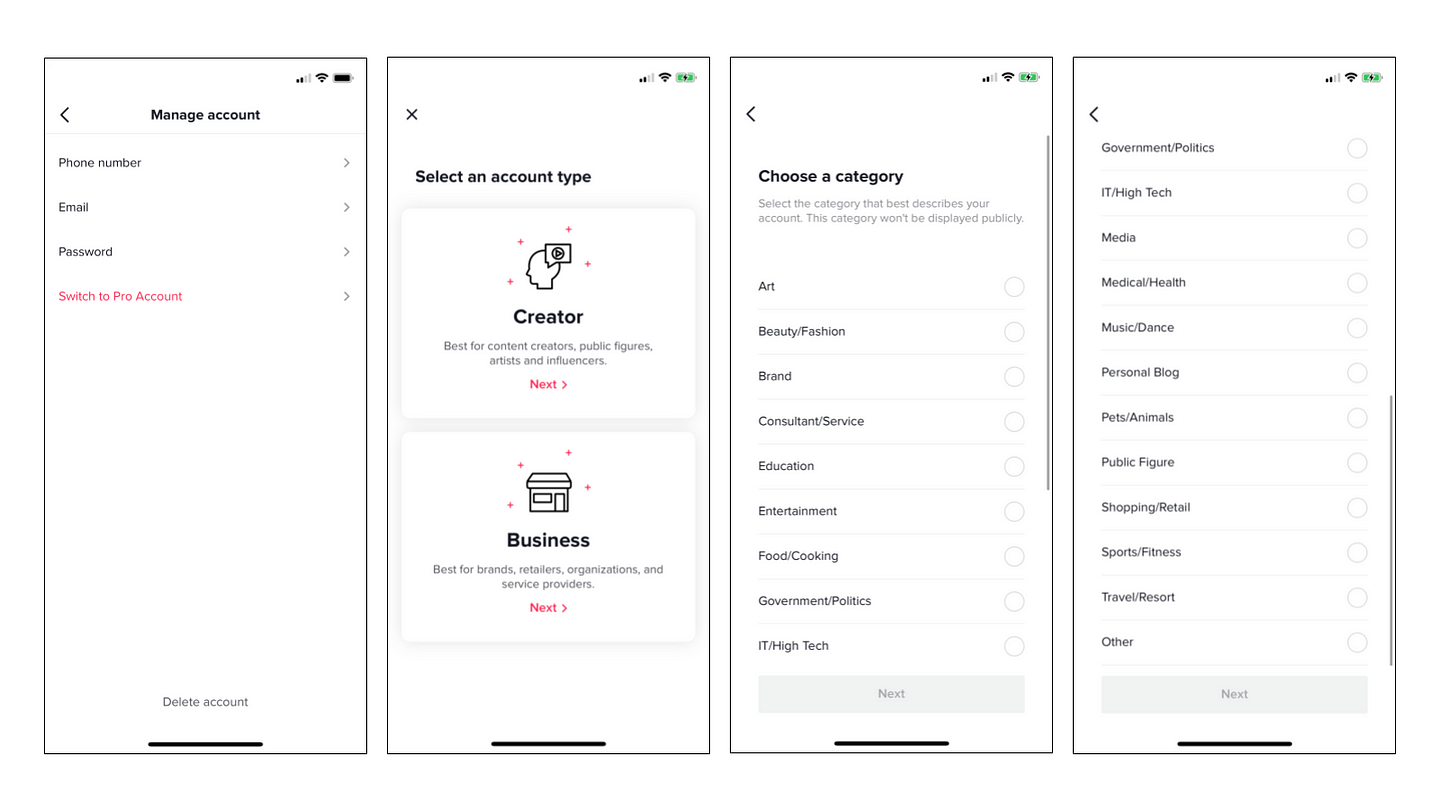
Now that your Pro Account is activated, you’ll find the analytics button under your account options on both desktop and mobile. However, analytics will only be available after a few days as activity ramps up on your account.
To access your TikTok analytics:
From your profile page (me tab at the bottom-right of the screen), open the Settings and privacy tab by tapping on the three dots on the top-right corner of the screen.
Tap Pro Account.
Tap Analytics.
TikTok analytics are pretty straight forward. In a recent Hootsuite blog post, Katie Sehl explains that “if your brand is new to TikTok, analytics can take some of the guesswork out of content strategy.” She adds: “Insights available to TikTok pro accounts can inform everything from when you post to what you post.”
There’s a lot of literature out there to understand and leverage TikTok metrics.
Personally, some of the most important analytics you might want to monitor constantly are found under the Followers tab — the three main analytics tabs are Overview, Content, and Followers.
When you tap on Followers, two key metrics are:
Follower activity (by hour) provides the time of day when your followers are most active on TikTok and thus helps users select the best time to post a TikTok video.
Sounds your followers listened to provides a short list of sounds and music that are popular among your followers during the last 7 days. This could be of help to select sounds and music to accompany your new TikTok videos.
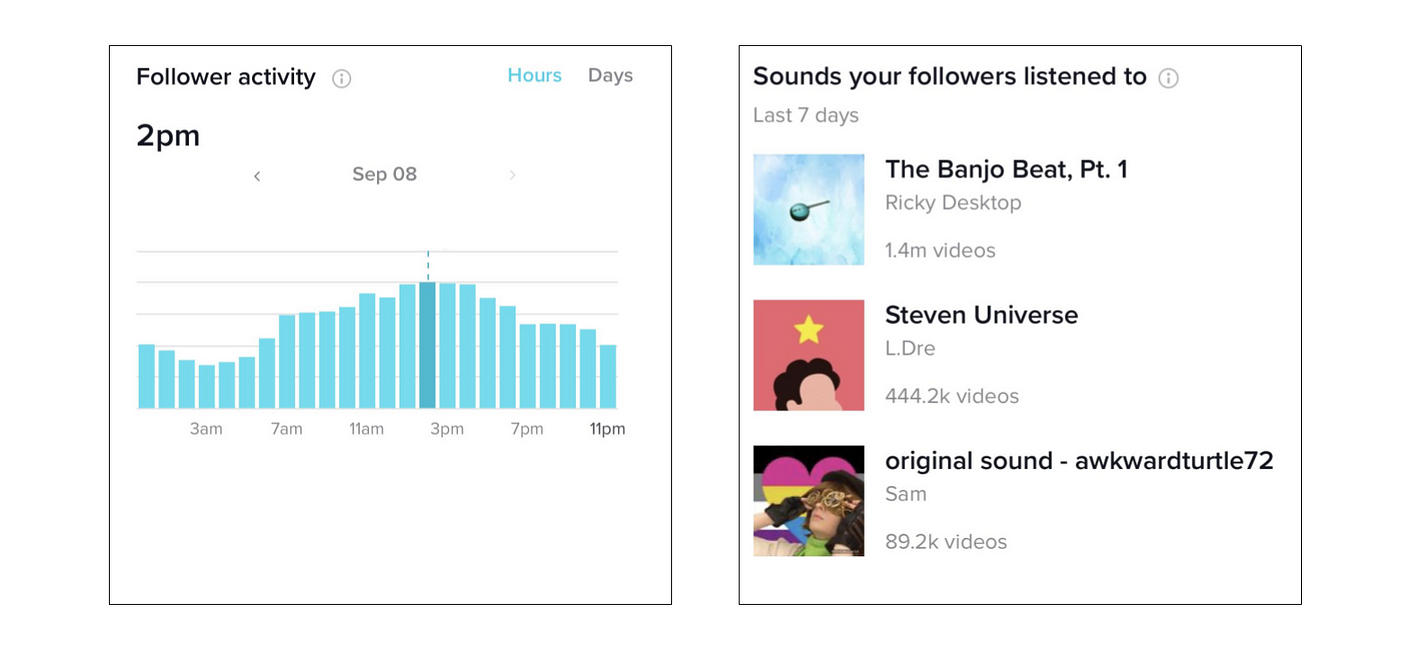
Lastly, every video you posted on your feed contains analytics that could be useful to plan future videos. To access the analytics for each video:
tap on the video you’d like to get the analytics for;
tap the 3 dots on the right side;
tap Analytics;
the top metrics on the screen are likes, comments, and shares;
a key metric to monitor is Traffic Source Types, or where your video traffic comes from, which includes the For You page, Personal Profile, Following, Sound, Search, and Hashtag.
How to get verified on TikTok
Like for other social media and content platforms, a verified blue checkmark next to a username indicates that the account is the authentic presence of a creator, brand, organization, or public figure.
As I mentioned earlier in this handbook, TikTok is still a young platform. As such, there is no preset way to request your account to be verified. And the verification procedures, requirements, and times might change whether your organization is global or local and in what market/region your main office is located.
If you are a global, regional, local governmental, non-governmental, charity, or non-profit the best way is to contact TikTok in your market directly — you can use the TikTok for Good contact page, or contact a TikTok team member via other social media platforms. In my experience they are all very responsive and happy to help social impact organizations set up a verified presence on the platform.
Even before the verification process is in motion, the best way to proceed is always to use an official email when you set up your account, and to link your Instagram account on TikTok. They use both to vouch for authenticity, in addition to possibly requesting other documents to attach to your request.
Hyperlinks on TikTok?
While links are not a big thing on TikTok, both the platform and the users have been experimenting quite a bit with them.
As mentioned above, it is important for users to link their Instagram and/or Youtube accounts when setting up your profile on TikTok — it is even more important if those accounts are verified and you’re hoping to have your TikTok verified as well.
Also, if you’re verified or if you have more than 1,000 followers on TikTok, you’ll be allowed to add a link to your profile page, right under the description of your account.
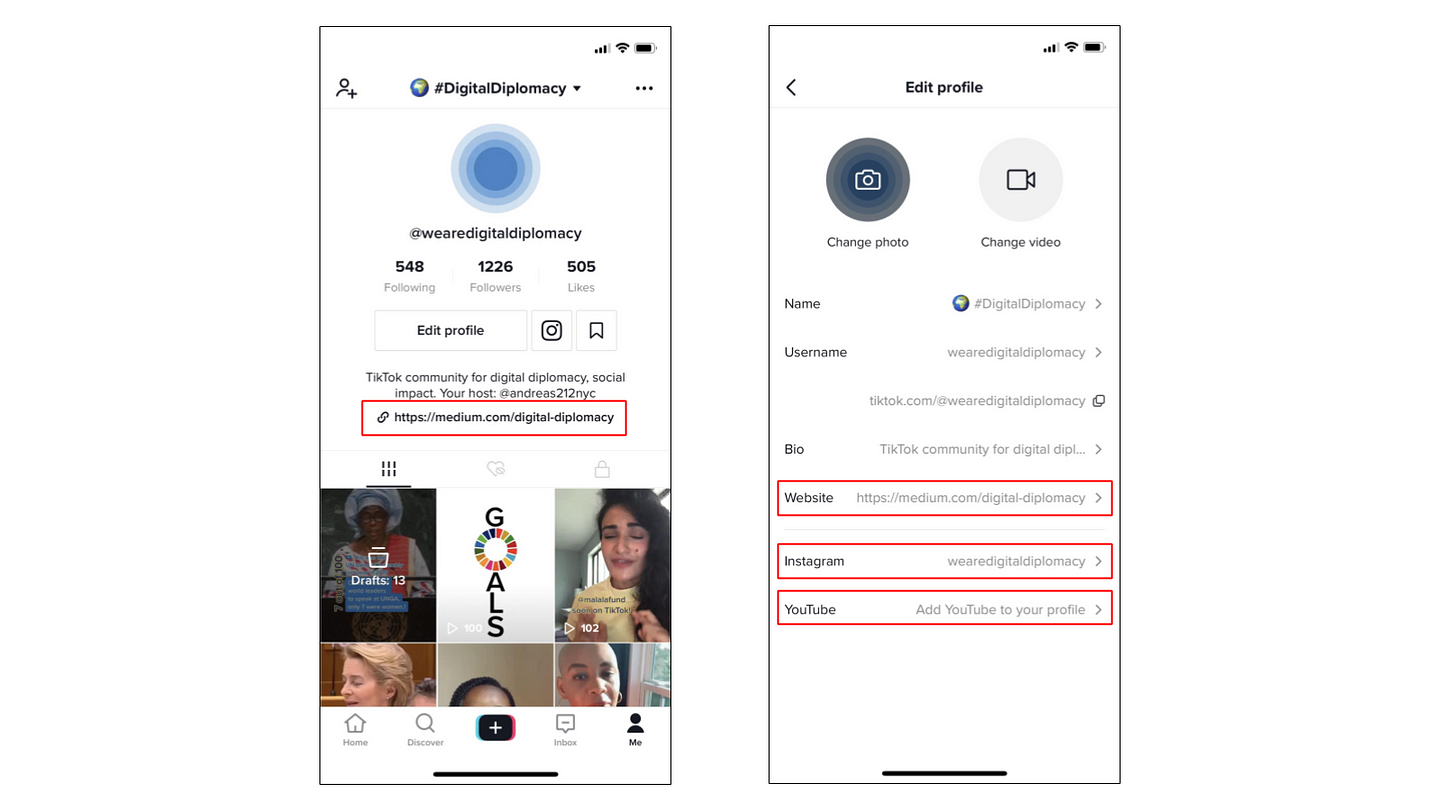
Another interesting option that TikTok has been experimenting with — and is available for selected accounts — is using links for videos and email links.
While it seems that for now the selection of links you can add to videos is only limited to TripAdvisor, Wikipedia, and Yelp, the option is available to both verified and unverified users.
“It’s an interesting option, providing another way to add more context to a TikTok clip,” writes Andrew Hutchinson in SocialMediaToday. “From a digital marketing standpoint, it’s obviously not as beneficial as adding a link back to your own website, but it could be good for UGC [user-generated content], with users potentially able to highlight your business via external links, which could entice TikTok viewers to visit.”
The screenshots below show how the Wikipedia link looks like on a video posted recently by Swiss President Simonetta Sommaruga, and what you get when you tap on the link.
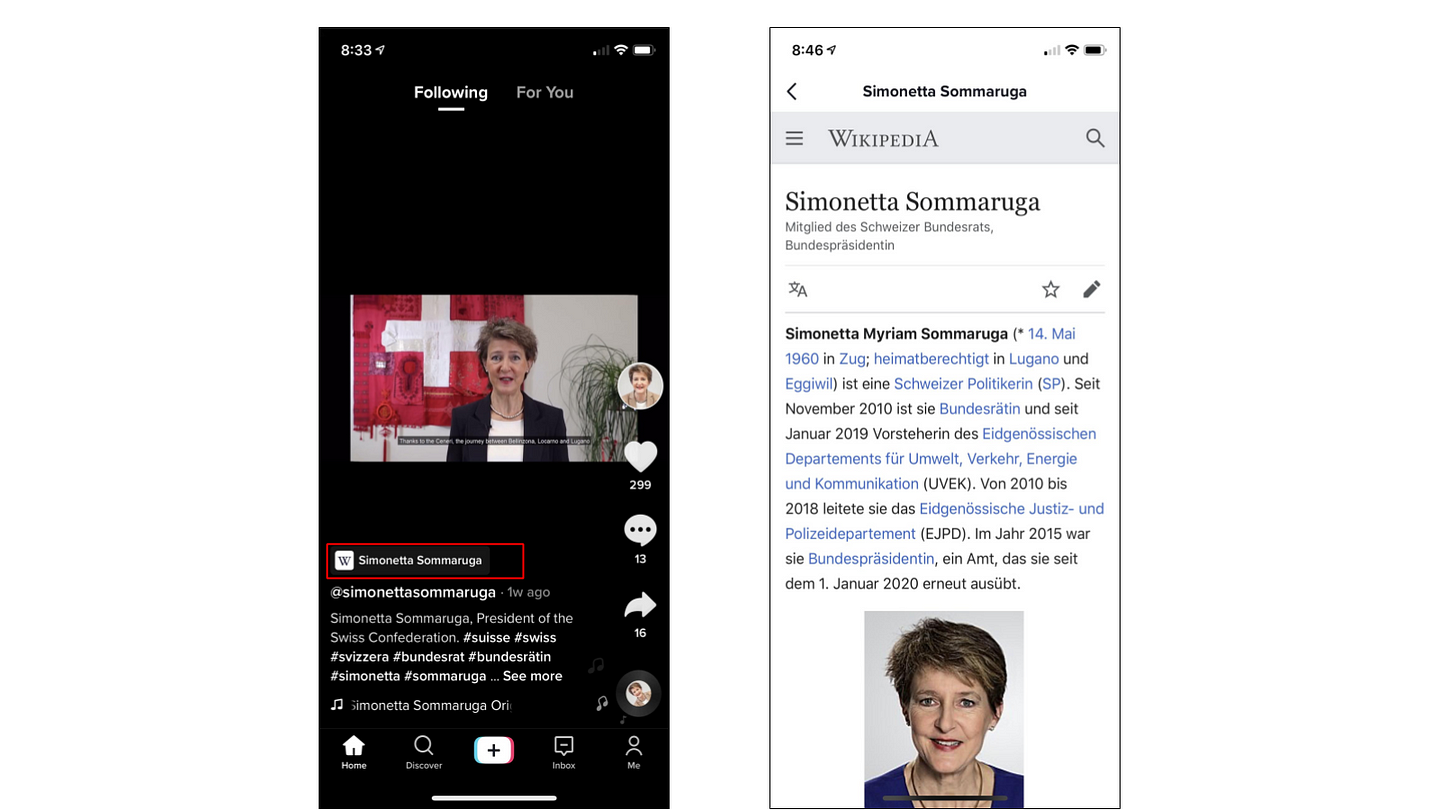
For You — and only for you!
“TikTok understands its users better than any other major social network seems to,” writes Angela Lashbrook in OneZero after interviewing a dozen internet communication experts and TikTok fans. “The algorithm is almost terrifyingly accurate at predicting what people want.”
The For You page is at the heart of TikTok and TikTok’s algorithmic success. This is what makes TikTok TikTok and what differentiates it quite substantially from other platforms. It is an effortless way to explore content and to get inspired to create your own inspiring content.
“Instagram makes you go to content, but TikTok brings content to you.” — Julia Alexander in The Verge
Getting your video content to appear on the For You page is not as difficult as you might think — it happens quite frequently — but the success of your content will depend on how users will engage with your videos.
For You is governed by a machine learning algorithm whose inner workings were recently revealed by the company.
“Imagine an algorithm so clever it enables its builders to treat another market and culture as a complete black box,” writes Eugene Wei, a former product guru at Amazon, Hulu, Flipboard, and Oculus, in his blog. “What do people in that country like? No, even better, what does each individual person in each of those foreign countries like? You don’t have to figure it out. The algorithm will handle that. The algorithm knows.” wrote in his blog post. “And why many, like me, have come to find TikTok a much more fun app to spend time in.”
According to Sara Fischer at Axios, during a recent call with reporters, TikTok’s executives explained that the platform’s algorithm “uses machine learning to determine what content a user is most likely to engage with and serve them more of it, by finding videos that are similar or that are liked by people with similar user preferences.”
Here’s what Axios reported about the algorithm:
“When users open TikTok for the first time, they are shown 8 popular videos featuring different trends, music, and topics. After that, the algorithm will continue to serve the user new iterations of 8 videos based on which videos the user engages with and what the user does.”
“The algorithm identifies similar videos to those that have engaged a user based on video information, which could include details like captions, hashtags or sounds. Recommendations also take into account user device and account settings, which include data like language preference, country setting, and device type.”
“Once TikTok collects enough data about the user, the app is able to map a user’s preferences in relation to similar users and group them into clusters. Simultaneously, it also groups videos into clusters based on similar themes, like basketball or bunnies.”
“Using machine learning, the algorithm serves videos to users based on their proximity to other clusters of users and content that they like.”
“TikTok’s logic aims to avoid redundancies that could bore the user, like seeing multiple videos with the same music or from the same creator.”
Axios also points out that “TikTok concedes that its ability to nail users’ preferences so effectively means that its algorithm can produce filter bubbles, reinforcing users’ existing preferences rather than showing them more varied content, widening their horizons, or offering them opposing viewpoints.”
Cross-posting your TikToks
Part of TikTok’s success is how recognizable TikTok videos are. They are ubiquitous across social media platforms. This is why cross-posting your TikToks is a key strategy to grow your visibility and audience.
No matter where you share your TikToks — on Instagram stories, Facebook, or Twitter — everybody will recognize they are TikToks and where to find them. That is because the watermark engrained in TikTok videos clearly indicates the account of provenance and username.
I’ve personally also shared my TikToks on LinkedIn and they have performed really well.
When you cross-post your TikToks on other platforms, keep in mind that:
it’s best to cross-post the video file rather than just the link — this is because videos are more engaging than links on any social media;
on Instagram, 15-second TikToks look best on Stories rather than feed posts — this is because post’s ratio is 1:1 or 4:5, while TikTok’s is 16:9;
longer TikToks can also be shared on multiple Instagram Stories;
if you have that option on Instagram Stories, just remember to add a clear call-to-action with a swipe-up link to your TikTok account;
a similar call-to-action can be added to your cross-posts on Twitter, Facebook, or LinkedIn.
In addition, when you cross-post your TikToks, there are different ways to download your videos that better suit specific platforms. These are my personal recommendations:
For Instagram Stories, Facebook, LinkedIn: tap the 3 dots on the right side of the TikTok video and choose Save Video. This will save your video as is on your cameral roll in a 16:9 format.
For Instagram feed posts: tap the 3 dots on the right side of the TikTok video and tap the Instagram icon. This will save your video on your cameral roll in a 16:9 format but will place your TikTok watermark and username on the screen with a 4:5 ratio. The downloaded video will also show your logo and username as an addition frame at the end.
For Twitter: tap the 3 dots on the right side of the TikTok video and choose Copy Link — I suggest not to tap on the Twitter icon as this would share a link on Twitter rather than a video file. After you copied the link, tap again the 3 dots on the right side of the TikTok video and choose Save Video. This will save your video as is on your cameral roll in a 16:9 format. Once the video is saved a new pop-up screen opens up: tap the Twitter icon or, if you don’t have it, tap Other and choose the Twitter icon. Another pop-up appears for you to compose your tweet (with a visible video file already attached) and paste the link you copied before downloading the video.
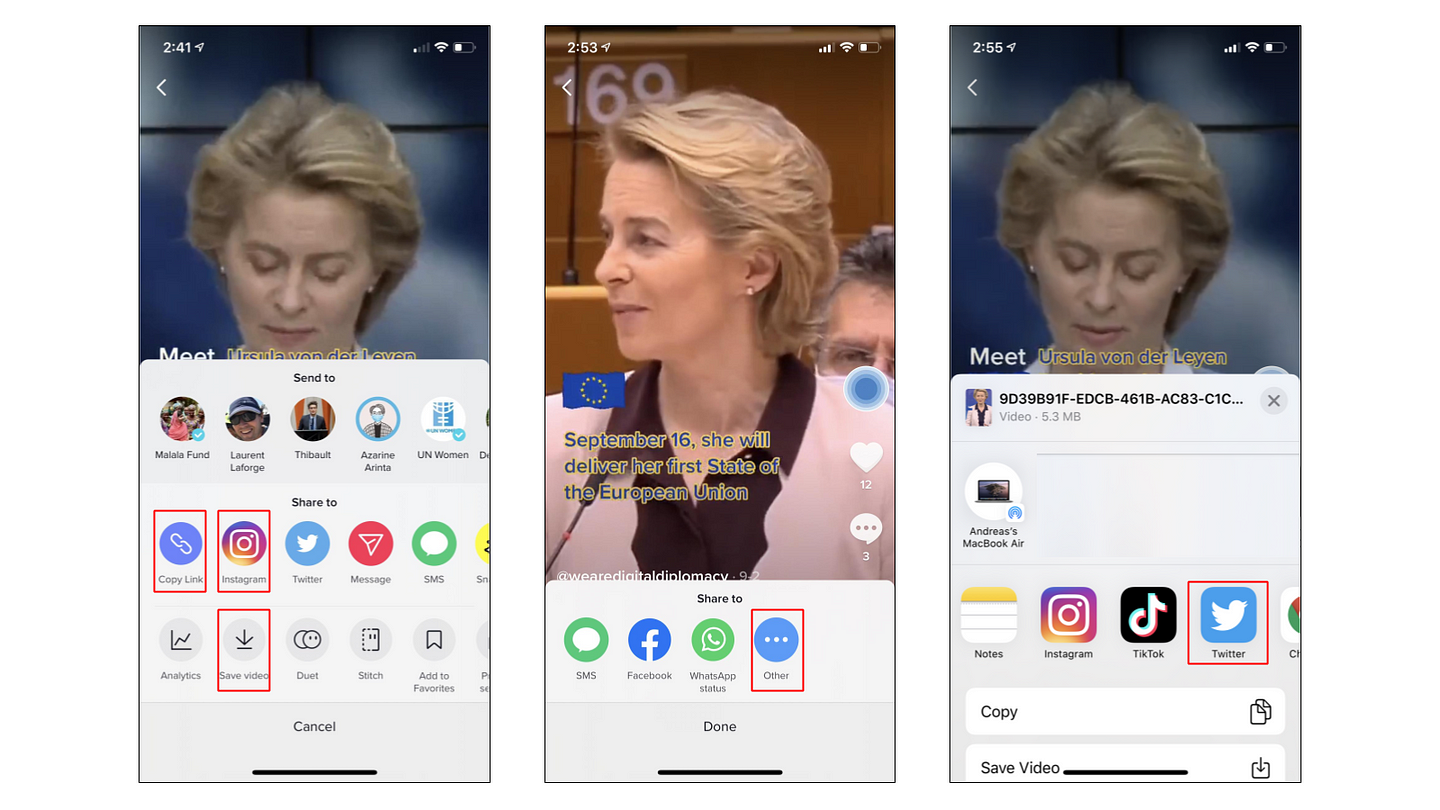
Go Live on TikTok… If you can.
Atthe moment it seems that the live feature on TikTok is only available to accounts with over 1,000 followers.
But don’t fret, because getting to that goal is not very difficult if your non-profit or social impact organization posts consistently on TikTok in addition to leveraging audiences from other platforms.
If you’re used to going live on other platforms, like Instagram and Twitter/Periscope, the live on TikTok works very similarly. The only difference that you need to keep in mind is that live videos disappear once the live is over.
To go live via the TikTok app:
tap on the + sign at the bottom of the screen;
tap on the LIVE option on the bottom right of the screen;
before you tap GO LIVE, edit the tag atop the screen (max 32 characters) by tapping the tag;
on the right side bar, you can choose Beautify filters, Props filter and features, and Share the link of the live.
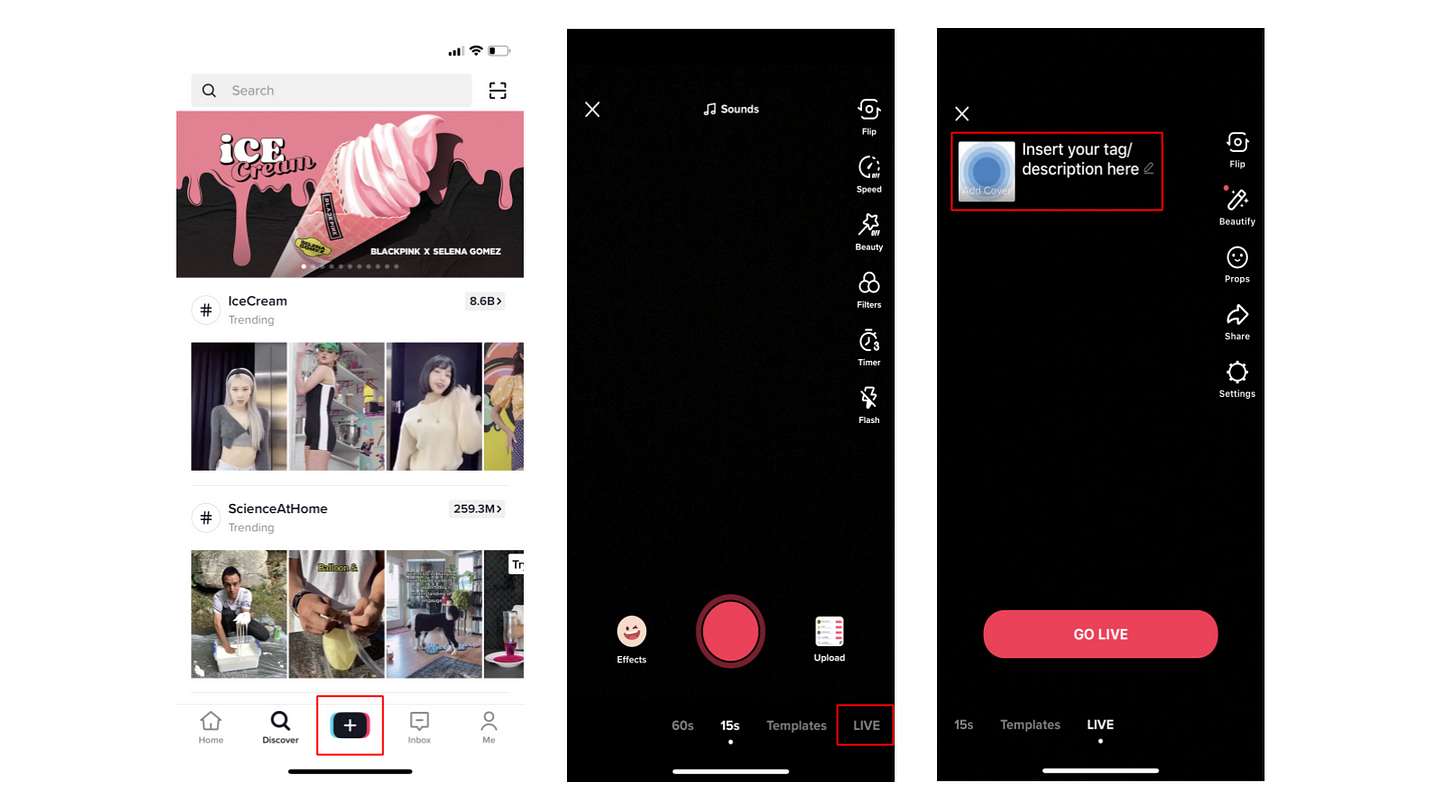
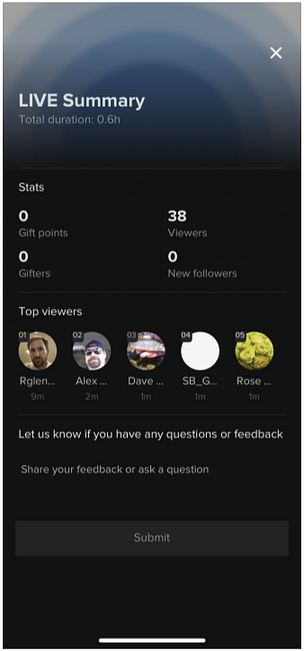
Once you’re live, you are still going to be able to Flip camera back and forth, copy the link to the live. You’re also going to be able to write comments. You’ll be able to see the number of users connected, the users joining the live, and the comments/questions they post.
To close the live, just tap the on/off icon.
The app will provide a brief LIVE Summary with information about:
total duration of your live;
the number of total viewers;
the number of followers you have gained during the live;
the top viewers and how long they watched;
the LIVE Summary also allows users to ask questions or send feedbacks.
TikTok creators are eager to collaborate
During this past summer, not only I was experiment with TikTok, explore the platform, and test its features. I also had the chance to work with several creators and influencers.
From creators Sam Schmir (@meatball) and Jackson Zaccaria (@jacksonstips) to actress and model Jess Adams (@thejessadams) and singer and songwriter Tiana Kocher (@tianakocher), they all have one thing in common: they’re passionate creators who are open to collabs and working with social impact organizations.
“A lot like in life, on TikTok the more you give, the more you’re going to receive,” Jackson told me.
Take Tiana, for example. During the height of the pandemic, she teamed up with TikTok influencers in a new campaign to benefit the Philippine Red Cross and the American Red Cross to assist them in the battle against COVID-19.
Inspired by her song Don’t Trip, Tiana challenged TikTok users from the United States, Canada, United Kingdom, and the Philippines with her #DontTripChallenge to support Red Cross medical staff and volunteers risking their lives daily amidst the global pandemic.
Tiana’s campaign also gather the support of tech companies Amazon and Lazada Group. In fact, users and creators who entered the #DontTripChallenge on TikTok had the chance to be selected to win a $50 gift card to Amazon or Lazada and have a $100 donation to the Red Cross made in their name.
“The #DontTripChallenge offers a fun in-home activity that users can enjoy and share with their friends while also giving back to COVID-19 mitigation efforts,” Tiana says.
According to Anuli Akanegbu, Internet culture scholar at the New York University (NYU), TikTok is changing the way influencers and creators approach advocacy and activism.
When I interviewed her, Anuli told me: “There’s so many examples, like @iambrattyb’s Black History Month series, or @singkirbysing calling out the history of Aunt Jemima brand.”
Through the summer I’ve seen many examples of collaborations between creators and organizations to support specific causes— some very large campaigns, some much smaller but still with a big impact.
In July, for example, TikTokers — check out the campaign video posted by creator Erin Sullivan (@erinoutdoors) — took on One Tree Planted’s challenge to #MakeAForest. For every video uploaded using the hashtag, One Tree Planted promised to plant a tree.
“The response to this challenge was both exciting and inspiring,” writes One Tree Planted’s Kaylee Brzezinski on a blog post. “The TikTok community showed up with ALL the creativity. We saw videos ranging from tree loving art projects to forest dances, as well as wildlife habitats for pets and indoor jungles! As a result, thousands of videos were created which will plant 3,554 trees in East Africa to help restore degraded lands for habitats of endangered chimpanzees!”
Asmentioned earlier in this handbook, working with creators is key for any campaign on TikTok. To reach out to creators on the platform:
start following creators that pop up on your For You page if you like the content they post;
many creators (with small or large followings) often includes an email address in their profile — if they don’t, you can always DM them on TikTok or check out their social media presence on other platforms to explore ways to contact them directly;
when you email or DM creators be succinct and explain why you’d like to partner — and whether you have a budget or you’re proposing a pro-bono partnership;
if you are a large non-profit, a nationwide or international organization, you might want to reach out to TikTok and explore ways for the TikTok for Good team to help outreach to macro-creators and big influencers on the platform.
Partnerships are key!
When this summer I interviewed Dante Licona at the International Federation of the Red Cross and Crescent Societies (IFRC) and congratulated him on their first 2 million followers, he said that “the key word has been partnership.”
Dante explained: “First, joining TikTok for joint campaigns, and also our Red Cross and Red Crescent network of amazing volunteers from all over the world.”
The IFRC was the major global humanitarian organization to join TikTok last year. They now count almost 3.5 million followers.
In a Medium post co-authored with Melis M Figanmeşe, Dante reminisced about the organization’s road to success on TikTok. It started when their “video guy and trend-spotter Damien Naylor suggested we take a look at the shiny new platform that was topping the charts of mobile downloads.”
“In April 2019, we took the plunge,” write Dante and Melis. “We reached out to TikTok’s team. They, unlike some other social [media] companies, responded fast. They were enthusiastic to get us on board and help in any way they could. We were paired with a representative that was actually an ex-IFRC staffer — so she would understand exactly who we are, how we operate, and at what speed.”
Fast forward a few months, a few posts on TikTok, and a campaign for World Blood Donor Day, in July 2019 “we started to have regular conversations in order to prepare a high-impact campaign, that could increase awareness and foster climate action,” reads the blog. “We not only held weekly conference calls, but through a Whatsapp group we were providing real-time updates to get things done. On one occasion, in a Zoom call with at least 10 participants, involving different elements of TikTok as well as our team, the result was: #ForClimate.”
In total, TikTokers created over 273,000 videos and the #ForClimate campaign generated almost 400 million views — the views have grown to over half a billion to date.
The TikTok for Good website points out that “with special effects, filters and stickers, TikTok users shared knowledge about climate change, drew attention to the impacts of extreme weather, and urged people to better protect our planet.”
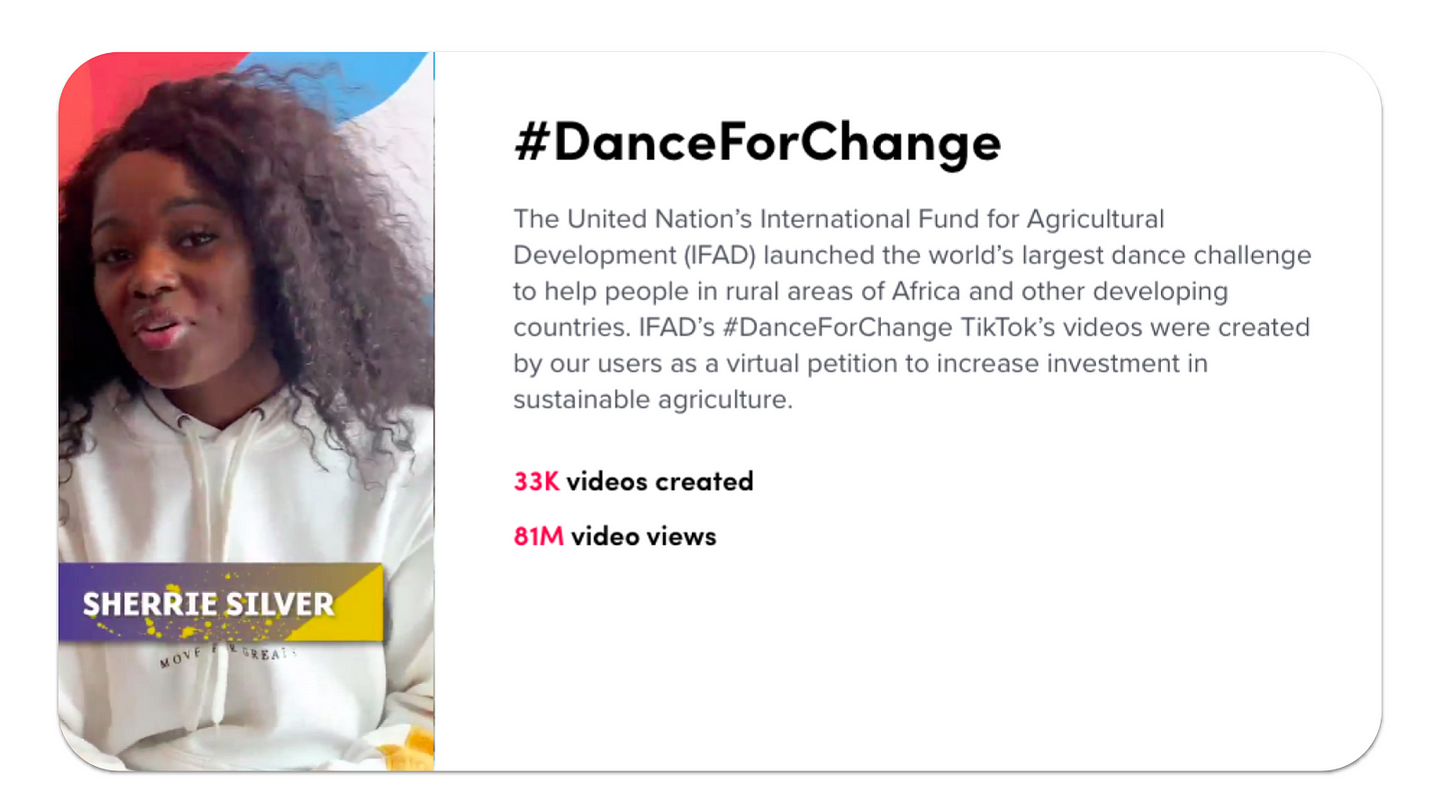
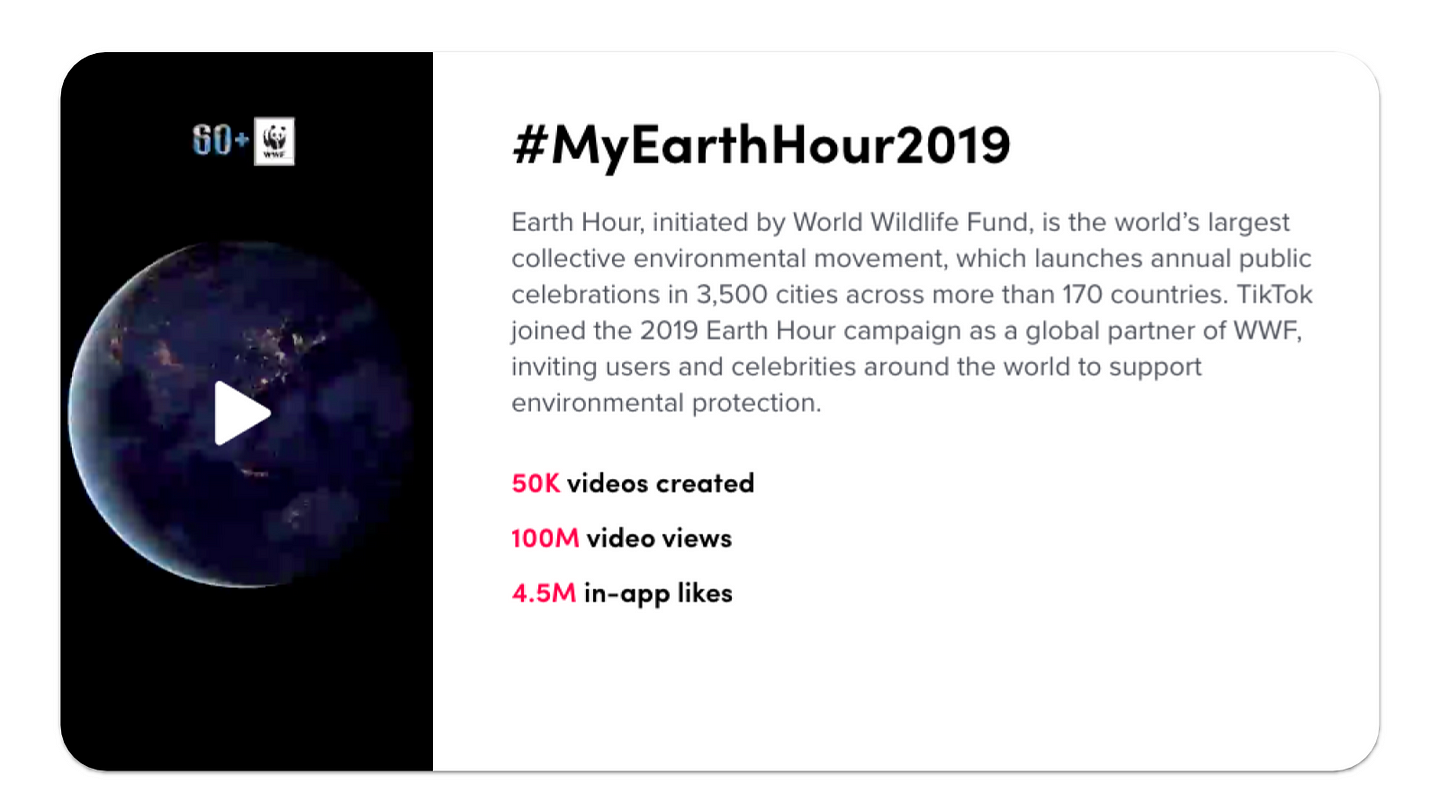 Above are some of the past campaigns and partnerships highlighted on TikTok for Good website.
Above are some of the past campaigns and partnerships highlighted on TikTok for Good website.Partnering with TikTok for Good was also key for the IOM - UN Migration. When I interviewed Luca Lamorte at the IOM, he ranked their partnership with the platform as one of their top 3 tips to success for large, complex organizations in the social impact and diplomatic space.
In a Medium post about their experience on TikTok, Luca explains: “Thanks to a strategic partnership with TikTok’s Corporate Responsibility Team, our corporate account has become the second most followed United Nations agency, even though IOM joined the platform quite late. TikTok has also topped IOM social media ranking worldwide, forcing us to recognize its potential.”
Another important partnership that developed this year was between the World Health Organization (WHO) and TikTok.
“It was a great opportunity for us to collaborate with TikTok to provide users with health-related information, educational content on health, to communicate health risks to younger audiences,” told me AleksandraKuzmanovic at the WHO, talking about the start of the global pandemic. “It was a strategic decision for us.”
Education and misinformation also came out in my interview with Nana Crawford at the British Red Cross, which counts almost 400,000 followers on TikTok, and a total of over 6 million likes on their videos.
Describing the British Red Cross’ impact on TikTok, Nana mentions how much they have done on the platform: “a donate campaign which helped raise £90,000 towards our coronavirus response; we’ve helped spread facts and not fear about coronavirus; we’ve basically just being trying to get people to understand more about the British Red Cross and I think it’s really landing.”
“We quickly realized that educational content is very popular on TikTok,” writes Nana in Civil Society magazine. “It is all about delivering information in fun and unexpected ways.”
She adds: “Taking popular songs and adding your own twist is a key way to deliver content that’s easy, relatable, and informative.”
Opportunities to combat misinformation
Not only the pandemic created new opportunities for social impact organizations and campaigns to reach new audiences, create awareness about front-line workers, and educate TikTok’s youngest generations about COVID-19, but it also posed many challenges.
First and foremost, how to respond and contrast misinformation, disinformation, and fake news.
“I think there are a lot of opportunities for social impact,” said marketing expert Lia Haberman at the University of California, Los Angeles (UCLA) in a TikTok interview with me. “You’ve got so much disinformation, so many conspiracies theories. You need official sources like the WHO, that joined in March, or Addison Rae and Charli D’Amelio, the [TikTok] influencers who helped with campaigns to educate people.”
In early August, TikTok US General Manager Vanessa Pappas announced new measures to fight misinformation on the platform and to “and keep misleading, harmful, or deceptive content and accounts off TikTok.”
She wrote in a company statement:
“We’re updating our policies on misleading content to provide better clarity on what is and isn’t allowed on TikTok.”
“We’re broadening our fact-checking partnerships to help verify election-related misinformation, and adding an in-app reporting option for election misinformation.”
“We’re working with experts including the U.S. Department of Homeland Security to protect against foreign influence on our platform.”
She also mentioned TikTok’s efforts around COVID-19. “While TikTok isn’t the go-to app to follow news or politics, we’re focused on supporting our users with education and authoritative information on important public issues,” Vanessa wrote. “This is why we partnered with NAMLE [National Association for Media Literacy Education] to launch our latest safety video series geared towards media literacy, and we continue to provide authoritative COVID-19 information and resources for our community.”
Top tips and best practices
“Keep with the feel of the platform. Be authentic. Make it silly, make it fun, make it joyful.” — Elizabeth Kanter, Public Policy Director at TikTok
The reason I started my TikTok summer video series was precisely to study and understand the many opportunities TikTok offers to non-profits, advocacy groups, and social impact organizations around the world.
Since the platform is so young, best practices are still being built and social good entities are eager to share their experiences and strategies.
The best tip? The one common thread in all the interviews is about being yourself on TikTok and don’t overthink it.
Lisa Goodchild, founder of Digilearning, puts it quite simply: “Be you, be true, and get creative!”
For organizations — large and small — finding that true self might be a bit more difficult than for creators. But I’ve seen it happening over and over again, with both global entities as well as local and regional non-profits finding their own unique voice on TikTok.
“You need to be creative, you need to be in the moment, and you need to take advantage of the trending hashtags,” says Rosemary Karinga at the UN Environment Programme (UNEP). “It’s impossible to know the full power of this platform — she continues — So my advice would be: dive right into it and figure it out as you go.”
“Just live and breath TikTok,” says Sylvie Francis at the UN Refugee Agency. Her top three tips for producing video content for TikTok:
make sure that your videos always tell a story;
try to use videos that are original and don’t just re-post videos from other social media platforms;
and make sure you include your stakeholders — the refugees themselves when it comes to UN Refugee — in developing your content ideas and production.
Justine Hu at IOM - UN Migration also has three quick tips:
keep it short;
use the discover page for trends and challenges;
and switch it up — diversify the type of content you post.
Part of what makes TikTok so popular and effective for social impact and digital diplomacy organizations is also its audience.
Sylvie explains that it is part of their strategy on TikTok and other platforms “to reach young and diverse audiences.”
She points out that “young people have a lot of compassion and really help change the narrative around refugees.” “And what is really lovely to see on TikTok — she adds — is a lot of young people coming to the support of refugees and defending them from haters and comments.”
Bhumika Regmi at the Malala Fund agrees and explains that “young women are passionate, knowledgeable, and really eager to make change.” This is why “Malala and the Malala Fund work to amplify their voices and create content that resonate with young women on our platforms.”
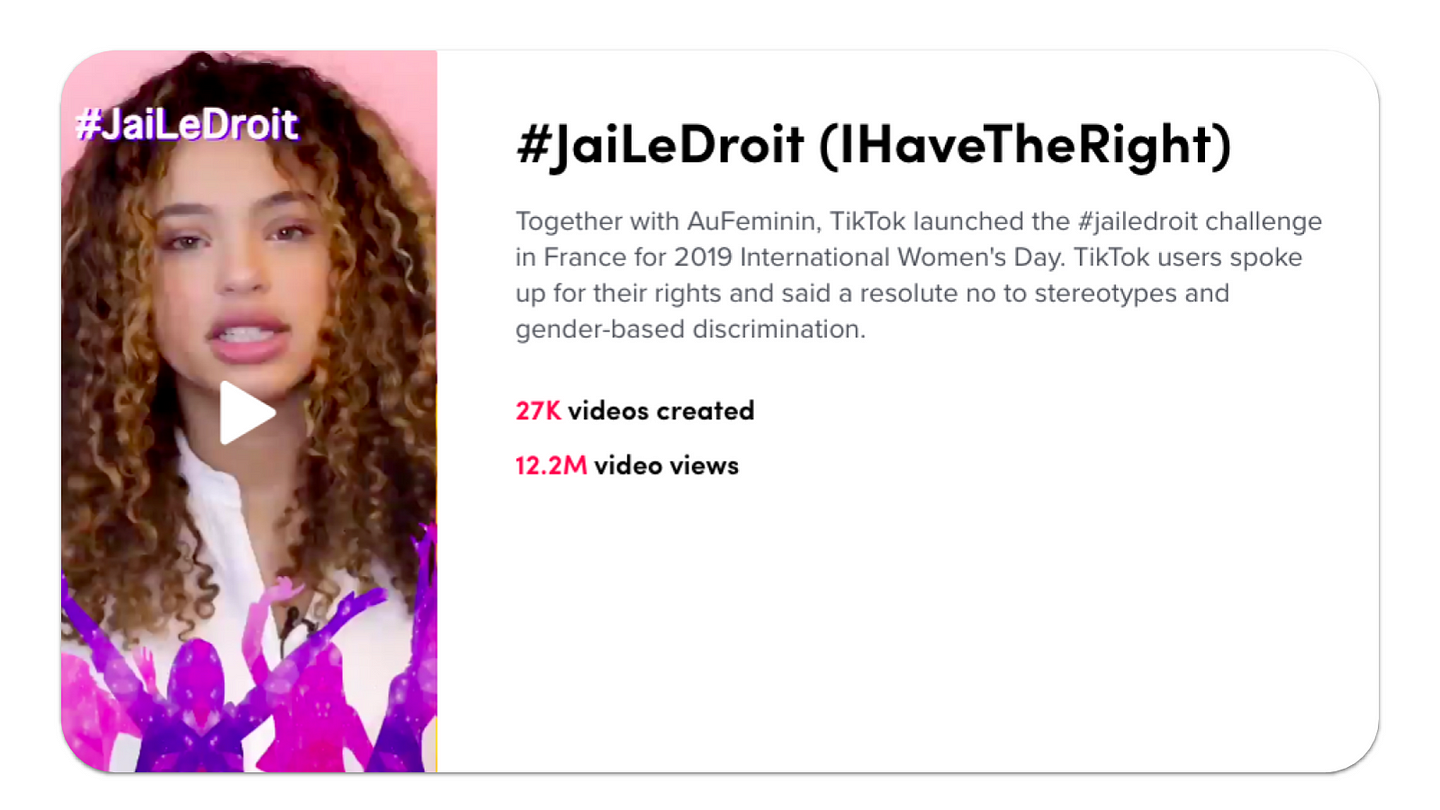
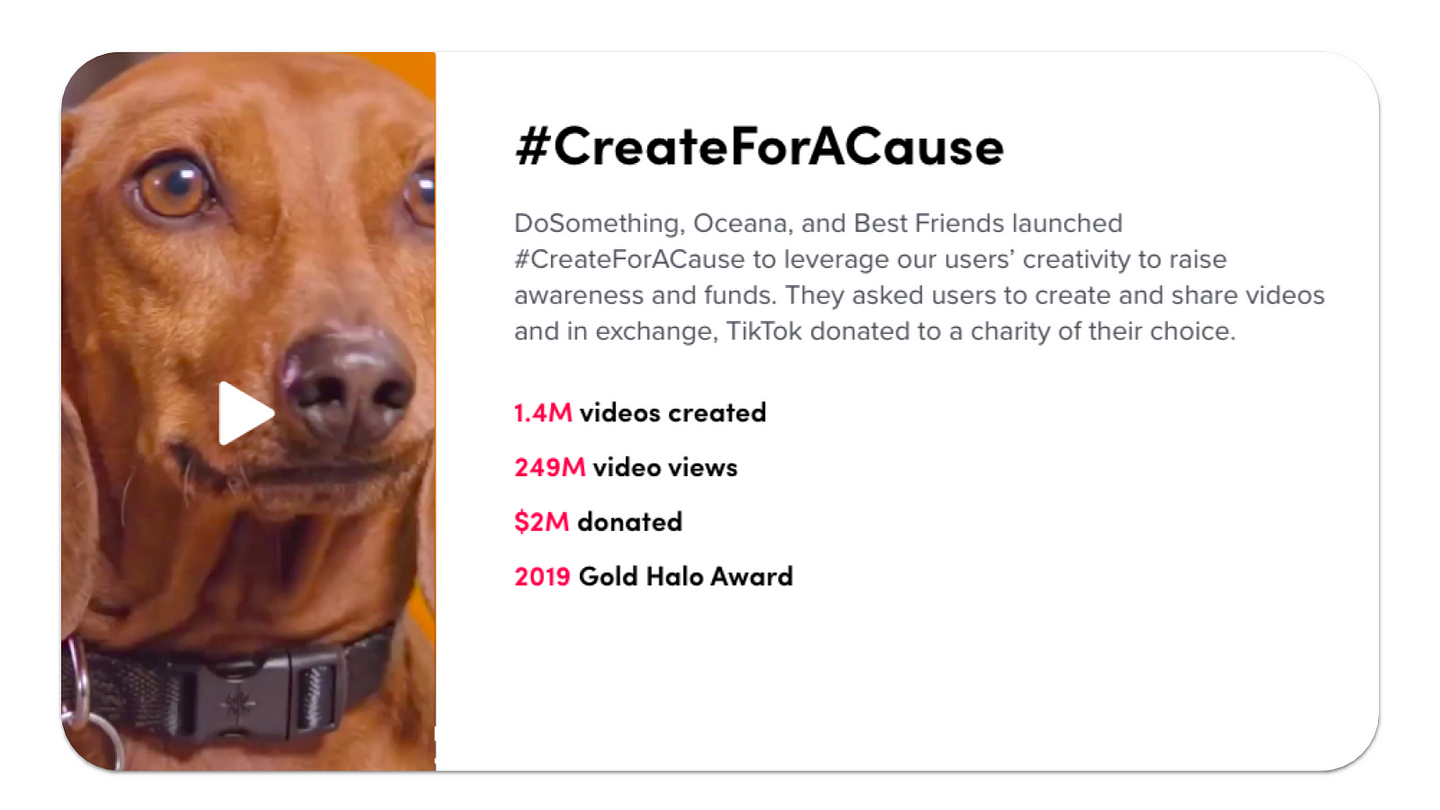
No comments:
Post a Comment